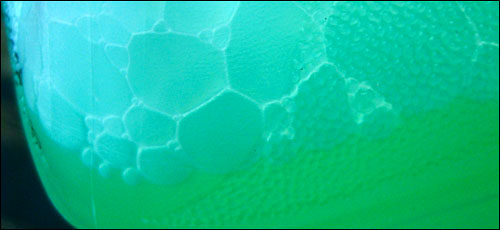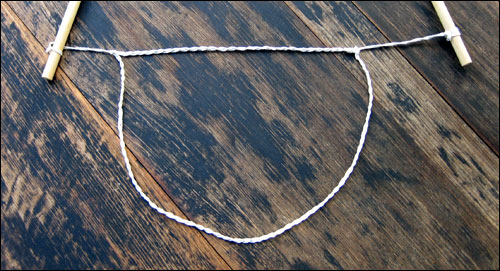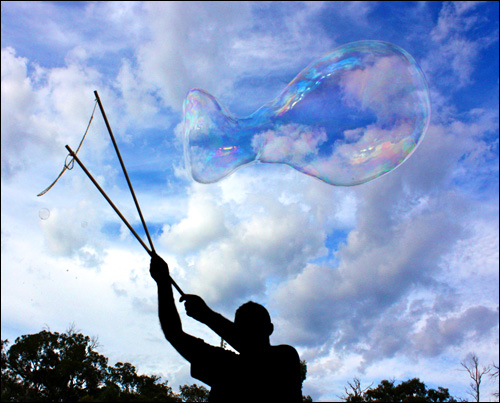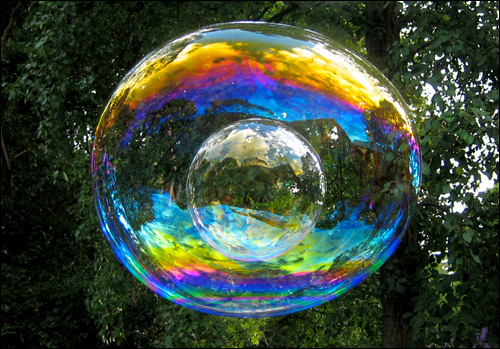Thu 22 Apr 2010
Science Experiment
Posted by anaglyph under Nostalgia, Photography, Science, Whimsy, Work
[22] Comments

Ingredients:
•150ml Glycerine
•100g KY jelly
•1 level tspn sodium bicarbonate (baking soda)
•1½ cups detergent concentrate
•1 cup hot water
•Filtered water to make up 2 litres
Hardware:
•1 x 2 litre plastic bottle
•1 small bucket
•2 x 1 metre lengths of wooden dowel
•5m natural fibre string

Method:
Dissolve the sodium bicarbonate in the hot water. Carefully mix in ½ cup of the detergent, all the glycerine and the KY jelly. Stir until dissolved as much as possible. Pour about 1 litre of cold water into the 2 litre bottle. Slowly pour in the remaining 1 cup of detergent, taking care not to make foam. Very slowly add the warm glycerine/KY/detergent/water mix. Add water to bring to 2 litres.
Gently rotate the bottle until the contents are mixed as much as possible (there will probably still be undissolved NaHCO3 and visible threads of KY & glycerine – don’t worry). Leave the bottle to stand for 2 days.

Meanwhile braid the string into a loop about the size of a basketball and attach to the ends of the dowel like this:

After two days have passed, check the solution and make sure it is completely uniform – there should now be no visible traces of any of the individual ingredients.
Now, go to a park or a beach – somewhere sheltered and not too hot. Pour some of the solution into the small bucket and dip the string into it – make sure you get it nice and saturated. Now do this:

You might even be able to make one like this…

Science! Just because something isn’t imaginary doesn’t mean you can’t believe in it…

___________________________________________________________________________
Bubble photos by Violet Towne.
___________________________________________________________________________
22 Responses to “ Science Experiment ”
Trackbacks & Pingbacks:
-
[…] matter how much stuff there is to know, there is always some more to find out, and as we saw in my recent science experiment, even the simplest of ideas can be full of rich and surprising consequences. Today I hope you will […]




I love it when faith is redundant.
Beautiful pics, so much fun, the bubble within the bubble is superb, I guess you used Schumann waves on that one…
Reminds me of the Thomas Dolby clip She Blinded Me With Science!
The King
Super pretty. But I have a better use for KY jelly
I’ll bet you do NM!
Is the smaller bubble inside the big one Malach’s brain?
The King
Should ingredients list 2½ cups detergent concentrate?
Because we are going to make Royal Ones tomorrow.
No – 1½ is correct. It was in error in the original post.
oops, 2 days! better make my mixture today for Anzac Day bubbles.
Where do you buy glycerine?
OK, own up. Who did the torture?
Glycerine is available from the supermarket – just go to the area that sells pharmaceuticals and look for stuff like eucalyptus oil and calamine lotion – it’s around there. And yes, important to let the solution sit until it is completely mixed – it will not be as good otherwise.
As for the torture, well, you have one of my recipes, and a very good one, but there are many tricks still to learn…
(Notice how I am just ignoring the smut. It was inevitable as soon as I mentioned KY)
What does Kentucky have to do with bubbles?
Twit.
oh Malach, you’re not supposed to eat it
Cissy: hahahaha
I think that last part will be my new motto.
Do you think adding any sort of metallic would maybe weld the bubble better and maybe make the color different?
I had’t thought of metals in the bubble, but it’s certainly an experiment you could undertake. At the moment I’m working on improving the self-healing attributes of the bubbles. Certain kinds of gums like xanthum and hydroxymethylcellulose (both common additives) seem popular in the bubble-making community (oh yes, there is one!). I think metal additives might make the bubbles more fragile (no reason for supposing that – just a hunch). The art is in getting the right balance between the surfactant properties of the detergent, the hydrostatic properties of the water, the evaporation characteristics and the weight of the whole shebang. Too much of one or the other and the bubbles suffer. The temperature and humidity of the air also makes a big difference.
My aim is to make the best bubbles I can with ingredients you can buy off the shelf at the supermarket. Xanthum and h-methylcell are common enough materials but you do have to go out of your way to get them.
I was also wondering about adding luminous inks to see if I can make bubbles that you can see at night…
I would think something like mag or aluminum oxide would be light enough, but maybe hard to find, depending on your resources.
That glowing bubble idea also made me think of the possibilities of a sustainable, flammable bubble, in which case mag or Al oxides would be an experiment of possibly epic coolness.
There’s one guy who makes bubbles and fills them with what I assume to be propane. They sink pretty fast (‘cos propane is heavier than air as you know) but he gets a flame to them and they explode pretty spectacularly. It occurs to me that if you could get hydrogen gas into them they would zip upwards but the problem might be igniting them…
***IF YOU ARE A CHILD DO NOT ATTEMPT THIS***
***PARENTAL ALERT POST***
I was thinking we could use a laser to ignite it after it floated up a ways, say 20-100ft…
Would be great to show children the power of explosions and the power of lasers so they can learn to respect it and understand it.
For short bursts you can hack a normal laser pointer to put out 20-100mw instead of 5mw by altering the control module (snip a thing here, twist a dial there). Instructions for this are everywhere.
The thing is that it’ll tear up the unit rather fast but you’d only need a fraction of a second pulse.
Crack open a junk IR remote control, yoink out the led, and wire those leads to your control board such that it becomes the power supply to the laser pointer instead of the battery holder it came with. Tap any button and you get a few pulses out; hold a button for continuous pulses.
Be sure to check for appropriate voltages with a meter, yada yada yada, and use a resistor if needed.
Also, it’s possible the default 5mw might be more than plenty just to pop the bubble and ignite the hydrogen. You’d need to have a large time on target so a steady hand is required. Obviously you wouldn’t need the above mentioned pulser system if you are going to be using it just for stock 5mw :)
P.S. If you decide to hack your laser pointer, and assuming it works, be really damn careful because you are potentially putting out enough laser power at that point to permanently blind people in a real big ass hurry should they catch a reflection or be in the wrong place when you turn it on.
This is why we current limit the modules to 5mw, but it’s also why this technique even works. It’s too costly to make all those different power modules, so we just make a one size fits all unit and use control boards to keep things sane.
In most cases these are the same units you’d get in a dvd burner where the outputs aren’t constrained.
If you do any of the above (I certainly ain’t going nowhere near it!) make sure you post us some pix!